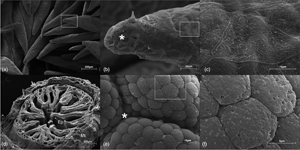Article contents
Morphological characterization of the digestive tube of hawksbill sea turtle (Eretmochelys imbricata) hatchlings
Published online by Cambridge University Press: 05 September 2022
Abstract

Morphological studies concerning the digestive system can further information on animal diets, thus aiding in the understanding of feeding behavior. Given the scarcity of information on sea turtle digestive system morphology, the aim of the present study was to describe the digestive tube (DT) morphology of Eretmochelys imbricata hatchlings to further understand the diet of these individuals in the wild. DT samples from 10 stillborn turtles (undefined sex) were analyzed at the macro and microscopic levels. The esophagus, stomach, small intestine (SI), and large intestine (LI) are described. Histologically, the DT is formed by four tunics, the mucosa, submucosa, muscular, and adventitia or serosa. The esophagus is lined by keratinized stratified squamous epithelium, while the remainder of the DT is lined by a simple columnar epithelium. The esophagus mucosa is marked by conical, pointed papillae. The stomach comprises three regions, the cardiac, fundic, and pyloric and is covered by neutral mucous granular cells. The intestinal mucosa presents absorptive cells with microvilli, neutral and acidic goblet cells, and mucosa-associated lymphoid tissue. The SI is significantly longer than the LI (p value = 0.006841). These morphological findings are strong indications of adaptations to a carnivorous diet in this hawksbill turtle age group.
- Type
- Micrographia
- Information
- Copyright
- Copyright © The Author(s), 2022. Published by Cambridge University Press on behalf of the Microscopy Society of America
References
- 1
- Cited by





